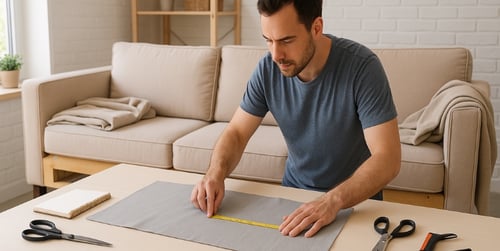Transforming a tired, worn-out sofa into a refreshed centrepiece for your living space can be both rewarding and practical. The process demands time, effort, and a bit of skill, but it offers a chance to revive a beloved piece without the expense of a full replacement. This guide provides a clear, actionable approach to tackling the task yourself, alongside insight into the necessary equipment and considerations for when expert help might be the wiser choice. Whether your goal is to update an outdated design or repair visible wear, the following steps and advice will equip you to decide if this project suits your needs.
Is reupholstering a sofa worth it?
Deciding whether to breathe new life into an ageing sofa involves weighing several factors. If the frame remains sturdy – crafted from solid wood rather than flimsy particleboard – the endeavour often proves worthwhile. A well-built piece can outlast its original fabric by decades, making sofa reupholstery a cost-effective alternative to purchasing anew, especially among durable sofas.
Sentimentality also plays a role; an heirloom or favourite piece may deserve the effort over a generic store-bought option. However, the undertaking requires patience – reupholstering a sofa can take days, particularly for novices.Costs vary widely: fabric alone might range from £40 to £400, depending on quality and how many metres are required, while labour, if outsourced, could climb higher. Compare this to a new sofa’s price tag – sometimes less than £800 for a basic model – and the choice hinges on value versus convenience. For minor damage, like faded upholstery or small tears, recovering a sofa makes sense; extensive structural issues, though, might tip the scales toward replacement.
What do you need to reupholster a sofa? Essential tools and materials
Success in this project depends on having the right supplies ready. Opt for durable fabric like microfiber or canvas, requiring 10–20 metres based on sofa size. A heavy-duty staple gun with 12 mm staples is essential for securing the new cover. Scissors or a rotary cutter ensure accurate cuts, and a measuring tape verifies dimensions. Use a screwdriver or pliers to remove old staples and disassemble parts, plus a seam ripper to detach existing upholstery fabric. Foam padding or batting refreshes cushions, available at craft or upholstery shops. A sewing machine, though optional, eases stitching for armrests, while chalk or a fabric marker traces patterns, and a rubber mallet aids frame reassembly. Collect these items in advance to streamline sofa recovering and prevent delays.
How to reupholster a sofa yourself – a step-by-step DIY guide
With tools ready, this methodical approach ensures a polished result.
Step 1: Assess the condition of your sofa
Begin by inspecting the piece thoroughly. Check the frame for cracks or wobbliness – solid construction is a green light to proceed. Examine springs and cushion filling; if they’re sagging or crumbling, plan to replace them during reupholstering. Take photos of the current state, noting how fabric attaches, to guide reassembly later. This step determines if the project is feasible or if costs might outweigh benefits.
Step 2: Remove the old fabric
Carefully strip away the existing cover. Use pliers to pull out staples and a screwdriver to detach any fastened sections, working methodically to avoid tearing usable pieces. Label each removed part – back, arms, seat – with masking tape to track their placement. This stage of sofa upholstery can be tedious but sets the foundation for a clean slate. Keep the old material intact as much as possible for the next phase.
Step 3: Make a pattern from the old upholstery
Lay the removed fabric flat and use it as a template. Trace each piece onto your new material with chalk, adding an extra inch around edges for seam allowance. This step in how to recover a sofa ensures the new cover fits snugly. If sections are too damaged to trace, measure the sofa directly and sketch accordingly. Precision here prevents waste and awkward gaps.
Step 4: Cut and prepare the new fabric
Cut the traced pieces with sharp scissors or a rotary cutter, following your marked lines. Smooth out wrinkles and double-check measurements before proceeding – accuracy matters in upholstery projects. If sewing is required, like for cushion covers, stitch now with a machine or by hand, leaving openings for stuffing. Iron the fabric lightly to ease attachment.
Step 5: Attach the new fabric
Start securing the new cover, beginning with the frame’s base. Pull the fabric taut and staple it in place, working from the centre outward to avoid puckering – corner sofas may need extra care at angles. Move to the back, then arms, and finally cushions, ensuring a firm fit. Trim excess material as you go. This core phase of how to cover a sofa demands patience for a professional look.
Step 6: Add the finishing touches
Reattach any detached parts, like legs, with screws or a mallet. Stuff cushions with fresh foam if needed, then sew or staple them closed. Smooth out creases and check for loose staples, reinforcing where necessary. Step back and admire your handiwork – a revitalised sofa emerges from your efforts in sofa reupholstery.
When to hire a professional or simply buy a new sofa?
Not every sofa warrants a DIY overhaul. If the frame’s broken beyond repair or the process feels overwhelming, hiring an expert might save time and frustration – though expect to pay £400–£1,500, depending on complexity and how much reupholstery costs in your area. Skill level matters too; intricate designs or delicate fabrics can stump beginners. Alternatively, if the total cost rivals a new piece – say, £700 for a decent replacement – buying might be smarter. A fresh sofa offers modern comfort without the labour. Weigh time, budget, and attachment to the old one before deciding.
Explore more topics:
Author: Dako Furniture Team



